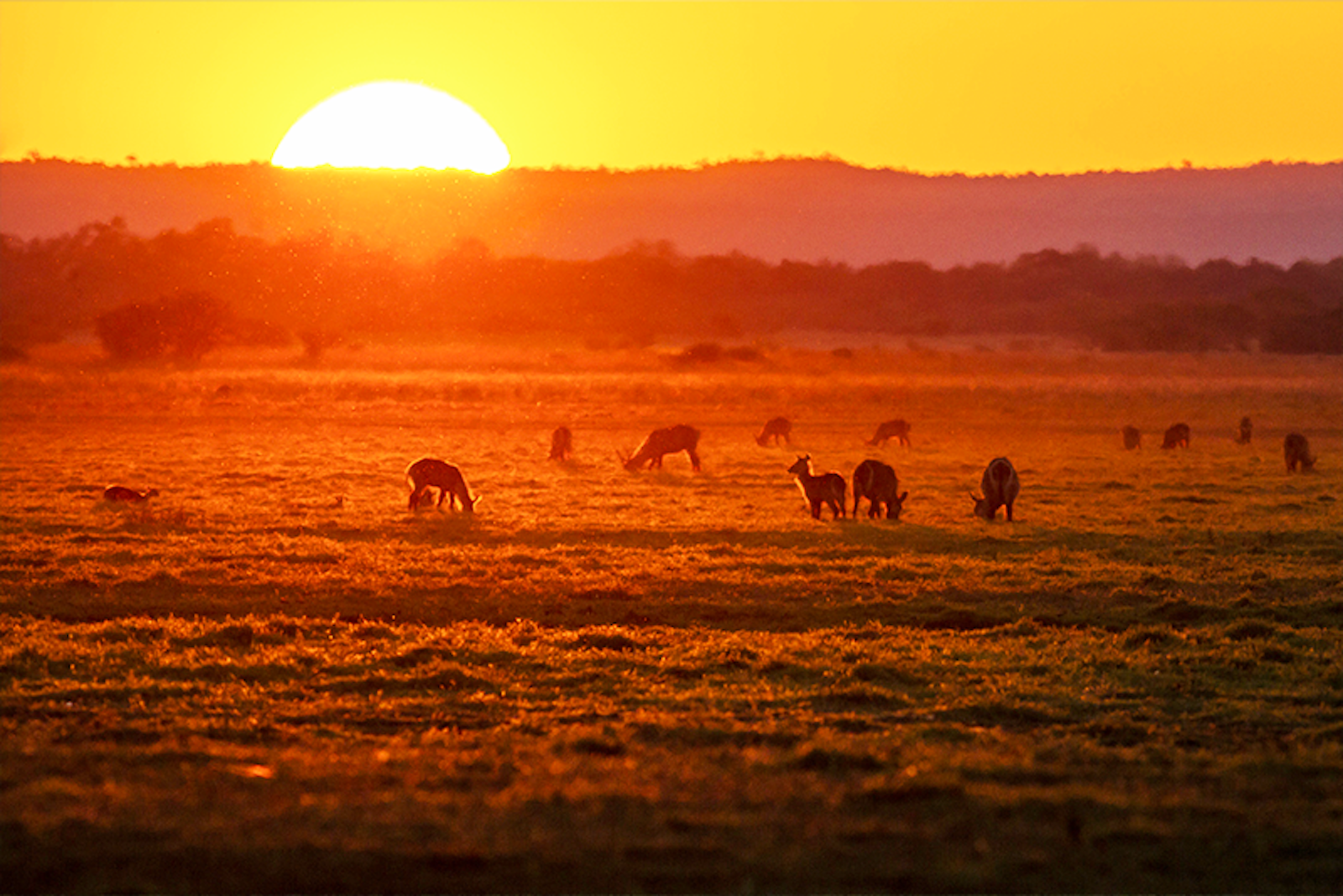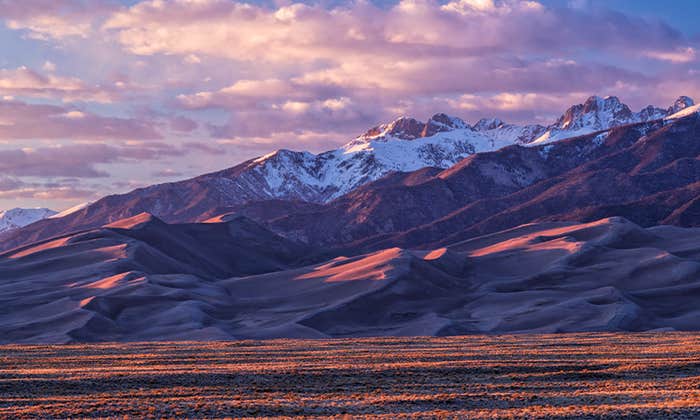
It’s early morning in Gorongosa National Park; the heat of the day is still a few hours off. Thick, dog-eared field guides crowd the space between the front seats of our safari truck; A Complete Guide to the Snakes of Southern Africa sits on top. The truck jounces over a few kilometers of bumpy roads with science technician Arquimedes André at the wheel.
Soon we see fences that section off the savanna into plots: some accessible to large herbivores, others not. We have arrived at the site of an ongoing, large-scale experiment to determine the role of fire and large herbivores in shaping diversity and structure of savanna ecosystems. The experimental area takes up about 487 acres of the million-acre park, and this morning we are pulling up to study a chunk of it.
Out of the truck tumbles André, a park ranger toting a long-barreled rifle, and two students in the Gorongosa master’s science program, Jonatá Joaquim Caminho and Iolanda Greedes Fernando Marcolino. We stand at the side of a plot approximately 100 feet by 100 feet—the size of two basketball courts—and Caminho explains what we are going to do: walk around and count species we see, logging them in a small journal and identifying them as best we can. Suddenly, he falls quiet. A low rumble means a lion is nearby. As soon as I recognize the sound, I feel glad the ranger has come along.
André, Caminho, and Marcolino are taking part in the Gorongosa Savanna Ecology Experiment, which allows researchers to monitor the presence of large mammals through intermittent “exclosures”—a fenced-off area that keeps large creatures out—to test the effects of early- and late-season fires on nutrient cycling in soils and vegetation, and on the insects, reptiles, amphibians, birds, and mammals that populate them. Tropical chemical ecologist Tara Massad, director of Gorongosa Master’s Program in Conservation Biology, launched the project in December 2020 as a platform to train students, mostly from Mozambique, in doing high-quality scientific research. But it is also providing invaluable insights into long-standing questions in savanna ecology.
Suddenly, he falls quiet. A low rumble means a lion is nearby.
A savanna is an expansive area of mixed grassland and woodland, with scattered trees that don’t form a closed canopy. About half of the African continent is savanna—and fire and the herbivory of large mammals such as antelope and elephants drive the ecosystems, “basically shaping our communities and affecting the rest of savanna biodiversity,” says Massad. These two major drivers influence such things as nutrient cycling in the soil and which plants grow where, as well as which animals can use the plants to survive, which makes understanding the system fundamental for studying savanna ecology—both in Gorongosa and around the globe.
Caminho’s project aims to understand the foraging response of birds in areas of the savanna where large mammals are present and fires have occurred. André is collecting similar data on lizards and snakes, and Marcolino is setting traps for beetles in this area to understand how they react to fires and herbivory.
André sets a cell phone timer for 20 minutes and we begin a slow, meditative walk around the perimeter of the plot, looking for any signs of life. My feet crunch the dry grass and I strain my senses to see what the scientists are observing—tiny turns of a white wing or a fragment of a song, the tail of a small lizard or a wing of a fluttering insect. Their senses seem honed to this environment in a way that takes months of focused practice.
Caminho is looking to identify species of birds but also to observe what they are doing, and how they are using their habitat. Are they foraging? Are they resting? As we walk, he holds a well-worn book with a sky-blue cover: Roberts Birds of Southern Africa. He tells me that he has always enjoyed birds. Growing up near the capital city of Maputo, he liked to hear their songs and see their colors. But as he has grown in his studies, his love has deepened: “Now it’s not only about the singing but their biology and behavior.”

The Gorongosa Savanna Ecology Experiment is intended as a long-term study and a research playground that allows Gorongosa students to contribute to a detailed understanding of savanna function. The experimental area consists of 10 blocks, each with six plots: three that are open to large mammal herbivores and three that are fenced off. (The open ones are very much within a lion’s range.) Of those six, two are burned early in the season, two are burned late in the season, and two aren’t burned at all—allowing scientists to understand how the effects of fire and large mammals interact.
Similar experiments exist in Kenya and in South Africa at Kruger National Park, but they aren’t designed to test the effects of fire regimes and the presence of large mammal herbivores in a fully crossed experiment, Massad says. Another aspect of the project in Gorongosa that sets it apart is that it is looking at biodiversity comprehensively, because students are studying multiple species. “Because of these little projects within the big project,” Massad says, “we’re able to understand not just how these factors influence the big mammals—which are usually what people care about—but also all the smaller and more biodiverse taxa as well.”
After one year of the experimental data has been analyzed, Massad is excited to see differences in the results from the plots. Researchers who take part in the project have found that in plots that are burned, there is more grass biomass—which is good for large foraging and grazing mammals. On the other hand, the plots that are open to herbivores have limited grasses—a result that is “not a surprise but it’s neat to see that happening within a year, and it’s also cool that it’s matching results from other parts of Africa,” Massad says.
Another finding is that both fire and herbivores limit the abundance and regeneration of shrubs—data that support similar conclusions in other parts of Africa. A big remaining question in savannas is how the balance of trees and grass is maintained. “How is it that it’s not just grasses that dominate or just trees?” Massad says. “Fire and large herbivores have different effects on grasses versus woody vegetation, and this experiment allows us to understand their interaction, which is likely to become stronger over time. In the future, we expect to see effects on tree growth as well.”
Their senses seem honed to this environment in a focused way.
Much of the human management of savannas is done through fire—burning allows for more grass to grow, which is good for tourist areas that want to attract antelope and other photogenic species sought after by tourists. But the experiment in Gorongosa has shown that fire has different effects on different species. While early-season fire was beneficial to small mammals, it led to a decrease in the abundance of amphibians. Massad says there are very limited studies about the effects of fire or large mammals on other animal taxa; in particular, there are few, if any, studies testing burn regimes on biodiversity outside of Gorongosa, making the results notable.
“By focusing just on using fire as a management tool for large mammals, people might not necessarily be promoting biodiversity holistically across savannas,” Massad says, “even though you might be giving tourists what they want to see, which is a good view of large grazing animals.”
Massad hopes that the experiment will run for 10 years. The longer it lasts, the more scholars will be able to learn about variations in climate and the impact of one-time events such as cyclones, in addition to the fundamental science of the plots.
After 20 minutes are up, I follow Caminho and André to another plot. The heat of the day begins to spread into the cracks between the trees and sweat gathers on my neck and back. At the end of three hours, my ankles are covered in insect bites, and we have seen only a few creatures, including a small blue waxbill and a black-backed puffback: a bird recognizable for the unique clacking noise followed by a whistle between songs. The only reptile André logs in his tally this morning is a skink that Marcolino has accidentally hacked apart when she was digging holes for her insect traps. It was probably hiding underground after the experimental plot was burned. We watch as its tail continues to wiggle, detached from its body.
The team will head back out in the evening to check the same plots at a different time of day, logging every observation. All that data will become part of a corpus of knowledge and lead to a fuller understanding of the intricacies of the savanna—to help conserve the ecological breadth of Africa for, yes, people, but also the animals and plants themselves. ![]()
Katharine Gammon is a freelance science writer based in Santa Monica, California, who writes about environment, science, and parenting. You can find her on Twitter @kategammon.
Lead photo by Piotr Naskrecki
The Nautilus Gorongosa Series is published in partnership with the Howard Hughes Medical Institute’s Science and Educational Media Group.




























